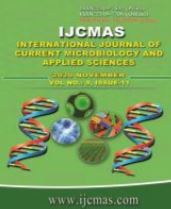


 National Academy of Agricultural Sciences (NAAS)
National Academy of Agricultural Sciences (NAAS)

|
PRINT ISSN : 2319-7692
Online ISSN : 2319-7706 Issues : 12 per year Publisher : Excellent Publishers Email : editorijcmas@gmail.com / submit@ijcmas.com Editor-in-chief: Dr.M.Prakash Index Copernicus ICV 2018: 95.39 NAAS RATING 2020: 5.38 |
Water and nitrogen are two primary limiting factors for wheat yield. In consonance with this, field experiment was conducted at Norman Ernest Borlaug Crop Research Centre in Pantnagar (Uttarakhand) during Rabi season of 2017-18 to analyze the performance of CSM-CROPSIM-CERES-wheat model for wheat cultivar (PBW-502) grown under different stress conditions characterized by inducing different water and nitrogen levels. 27 treatment combinations consisted of 3 DOS (12th December, 22nd December and 02nd January), 3 irrigation levels (100% irrigations, 75% irrigations and 50% irrigations) and 3 nitrogen levels (100%, 75% and 50% of recommended nitrogen doses) laid in a Factorial RBD with 3 replications. The results revealed good agreement between simulated and measured data of crop phenology, LAI and grain yield. The simulated and observed yield ranged between 1.5 to 4.95 t/ha and 1.42 to 4.73 t/ha, respectively. RMSE was found to be 11.61% with R2 value of 0.90, which is found significant. The model performance was validated with the experimental dataset of year 2007-2008 by using genetic coefficients obtained during calibration process. Degree of stress in wheat crop was analyzed in terms of yield gap, which was found higher (68. 28 %) under lowest levels of irrigation (2 irrigation) and nitrogen (75 kg ha-1).
 |
 |
 |
 |
 |